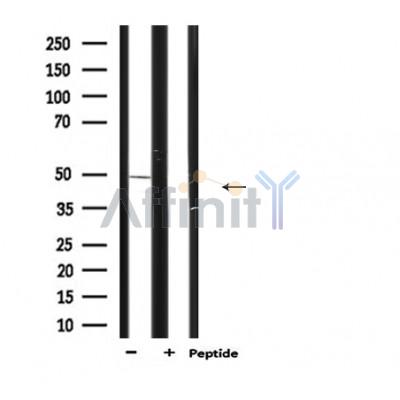ACTR3 Antibody - #DF6209
| Product: | ACTR3 Antibody |
| Catalog: | DF6209 |
| Description: | Rabbit polyclonal antibody to ACTR3 |
| Application: | WB IHC IF/ICC |
| Reactivity: | Human, Mouse, Rat |
| Prediction: | Pig, Bovine, Horse, Sheep, Rabbit, Dog, Chicken |
| Mol.Wt.: | 47kDa; 47kD(Calculated). |
| Uniprot: | P61158 |
| RRID: | AB_2838175 |
Related Downloads
Protocols
Product Info
*The optimal dilutions should be determined by the end user.
*Tips:
WB: For western blot detection of denatured protein samples. IHC: For immunohistochemical detection of paraffin sections (IHC-p) or frozen sections (IHC-f) of tissue samples. IF/ICC: For immunofluorescence detection of cell samples. ELISA(peptide): For ELISA detection of antigenic peptide.
Cite Format: Affinity Biosciences Cat# DF6209, RRID:AB_2838175.
Fold/Unfold
Actin like protein 3; Actin related protein 3; ACTR3; ARP3 actin related protein 3 homolog (yeast);
Immunogens
A synthesized peptide derived from human ACTR3, corresponding to a region within C-terminal amino acids.
- P61158 ARP3_HUMAN:
- Protein BLAST With
- NCBI/
- ExPASy/
- Uniprot
MAGRLPACVVDCGTGYTKLGYAGNTEPQFIIPSCIAIKESAKVGDQAQRRVMKGVDDLDFFIGDEAIEKPTYATKWPIRHGIVEDWDLMERFMEQVIFKYLRAEPEDHYFLLTEPPLNTPENREYTAEIMFESFNVPGLYIAVQAVLALAASWTSRQVGERTLTGTVIDSGDGVTHVIPVAEGYVIGSCIKHIPIAGRDITYFIQQLLRDREVGIPPEQSLETAKAVKERYSYVCPDLVKEFNKYDTDGSKWIKQYTGINAISKKEFSIDVGYERFLGPEIFFHPEFANPDFTQPISEVVDEVIQNCPIDVRRPLYKNIVLSGGSTMFRDFGRRLQRDLKRTVDARLKLSEELSGGRLKPKPIDVQVITHHMQRYAVWFGGSMLASTPEFYQVCHTKKDYEEIGPSICRHNPVFGVMS
Predictions
Score>80(red) has high confidence and is suggested to be used for WB detection. *The prediction model is mainly based on the alignment of immunogen sequences, the results are for reference only, not as the basis of quality assurance.
High(score>80) Medium(80>score>50) Low(score<50) No confidence
Research Backgrounds
ATP-binding component of the Arp2/3 complex, a multiprotein complex that mediates actin polymerization upon stimulation by nucleation-promoting factor (NPF). The Arp2/3 complex mediates the formation of branched actin networks in the cytoplasm, providing the force for cell motility. Seems to contact the pointed end of the daughter actin filament. In addition to its role in the cytoplasmic cytoskeleton, the Arp2/3 complex also promotes actin polymerization in the nucleus, thereby regulating gene transcription and repair of damaged DNA. The Arp2/3 complex promotes homologous recombination (HR) repair in response to DNA damage by promoting nuclear actin polymerization, leading to drive motility of double-strand breaks (DSBs). Plays a role in ciliogenesis.
Cytoplasm>Cytoskeleton. Cell projection. Nucleus.
Note: In pre-apoptotic cells, colocalizes with MEFV in large specks (pyroptosomes) (PubMed:19109554).
Belongs to the actin family. ARP3 subfamily.
Research Fields
· Cellular Processes > Cellular community - eukaryotes > Tight junction. (View pathway)
Restrictive clause
Affinity Biosciences tests all products strictly. Citations are provided as a resource for additional applications that have not been validated by Affinity Biosciences. Please choose the appropriate format for each application and consult Materials and Methods sections for additional details about the use of any product in these publications.
For Research Use Only.
Not for use in diagnostic or therapeutic procedures. Not for resale. Not for distribution without written consent. Affinity Biosciences will not be held responsible for patent infringement or other violations that may occur with the use of our products. Affinity Biosciences, Affinity Biosciences Logo and all other trademarks are the property of Affinity Biosciences LTD.



